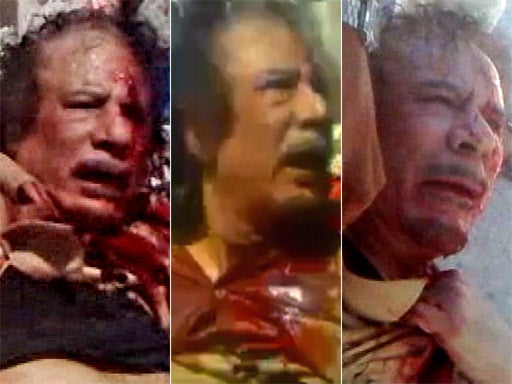The final hours of Libya's tyrant
A rights watchdog has revealed shocking details of Gaddafi's capture and death. By Peter Popham

Your support helps us to tell the story
From reproductive rights to climate change to Big Tech, The Independent is on the ground when the story is developing. Whether it's investigating the financials of Elon Musk's pro-Trump PAC or producing our latest documentary, 'The A Word', which shines a light on the American women fighting for reproductive rights, we know how important it is to parse out the facts from the messaging.
At such a critical moment in US history, we need reporters on the ground. Your donation allows us to keep sending journalists to speak to both sides of the story.
The Independent is trusted by Americans across the entire political spectrum. And unlike many other quality news outlets, we choose not to lock Americans out of our reporting and analysis with paywalls. We believe quality journalism should be available to everyone, paid for by those who can afford it.
Your support makes all the difference.The details of how Muammar Gaddafi died are well known: gruesome footage of him being manhandled by rebel militiamen after his capture last October went around the world. But a report by Human Rights Watch (HRW), drawing on interviews with close associates of the dictator who survived the final battle and rebels present at his capture, provides appalling new detail about his last hours.
Just years earlier, this man had been courted by Tony Blair and other world leaders. Now he was holed up in his home town, Sirte, and rapidly running out of food, patience and hope. Soon he was to die a hideous, humiliating death.
The report claims that at least 66 members of Gaddafi's convoy were summarily executed by the militias after their capture – a war crime which the Libyan civilian and military authorities have an obligation to investigate. So far they have shown no inclination to do so.
The authorities claim that Gaddafi was killed in crossfire during the final battle in Sirte, but the evidence amassed by HRW strongly suggests that he was, in effect, lynched. The testimony includes an admission by a key militia commander that "the situation was a mess … it was a violent scene … it was very confusing." Cell phone footage obtained by the organisation shows that among other injuries he was stabbed in the anus, probably with a bayonet.
Then during the night from 19 to 20 October, the remnant of Gaddafi's forces holed up in District Two came under intensive and continuous bombardment by rebel Grad missiles and artillery. Mutassim Gaddafi, Gaddafi's fourth son, who in command of defending the city, organised a break-out, loading civilians and the wounded into a convoy of 4x4 pick-ups, loaded with arms and ammunition. But the planned departure time, 3.30am or 4.00am, slipped to 8am, by which time the militia fighters were ready for them.
The convoy's hopes of breaking through the encircling forces were slim. They managed to reach a road leading south out of the city, but then a drone-fired missile exploded next to the car carrying Gaddafi. "It caused such a powerful blast that the air bags inflated and I was hit by shrapnel," Mansour Dhao, head of the People's Guard, told HRW.
Mutassim Gaddafi's way was blocked in every direction, and drones and war planes circled overhead. The road he now led the convoy down was blocked by a militia base but he headed straight for it.
"The convoy came towards our brigade building," militia commander Khalid Ahmed Raid recalled, "and shot at our gate with rocket-propelled grenades … so we began to fight back. They tried to go around our base … we opened fire on them with our [anti-aircraft] guns."
Nato planes then dropped two 12,500lb bombs on the convoy, destroying 14 vehicles, killing at least 53 people and forcing Gaddafi and his inner circle, all of whom survived, to flee on foot.
Mansour Dhao persuaded his chief that they should tunnel under the main road through drainage pipes to farms on the far side. But as soon as they emerged from the pipes, militia fighters were on to them. Gaddafi's guards threw grenades to force the militia back, but the third one they threw bounced back, exploding in their midst, killing the guard who threw it and wounding Gaddafi in the head. Militia fighters rushed to the drains, astonished to find Gaddafi there.
It was in the next three minutes and 38 seconds that the rebels' lust for vengeance erupted, captured in cell phone footage obtained by HRW. As soon as they had Gaddafi in their grasp, they began abusing him. Blood was already gushing from the shrapnel wound in his head. And as he was being led onto the main road, a militiaman stabbed him in his anus with what appears to have been a bayonet. Misrata fighters surrounded him, punching and beating him and yelling "Allahu Akbar!" and "Misrata!" over and over.
"The situation was a mess," local militia commander Khalid Ahmed Raid admitted: "It was a violent scene. He was put on the front of a pickup truck that tried to take him away and he fell off. It was very confusing. People were pulling his hair and hitting him. We understood there needed to be a trial, but we couldn't control everyone; some acted beyond our control."
When Gaddafi was eventually loaded into an ambulance, he was "nearly naked and apparently lifeless," HRW states. By the time he arrived in Misrata, a journey of at least two hours, he was "almost certainly dead".
Join our commenting forum
Join thought-provoking conversations, follow other Independent readers and see their replies
Comments